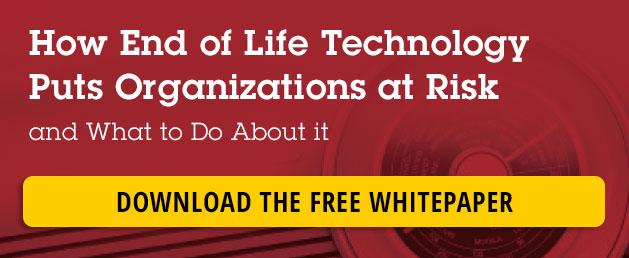Once you’ve weighed all the options and determined that it’s the right time to address End-of-Life technology, you need a game plan to make the transition smooth and painless. That’s where the experts at ABC Services can be most helpful.
Essentially, jettisoning outdated technology and adopting state-of-the-art hardware and software boils down to five succinct strategies that enterprises can employ to mitigate the risks of End-of-Life technology:
Partner with ABC Services. It’s important to align with an experienced, trusted technology firm to usher your business into the next phase of information management. At ABC Services, we take an objective look at the big picture — assessing your EOL situation along with your hardware and software needs. We can easily identify the risks of using EOL products, recommend viable solutions, and work with you to establish an efficient, ongoing, and cost-effective End-of-Life technology management plan.
Inventory and identify EOL issues. How can you determine if your technology is approaching End-of-Life? Five years is a good barometer: If you’ve been running software or hardware that long or longer, it’s a good bet your core tech is approaching End-of-Life. At ABC Services, we recommend taking a complete technology inventory to gauge the age of all products. (The OEM or a manufacturer’s rep can help to identify technology that’s approaching End-of-Life.) Commercial configuration management software outfitted with End-of-Life tracking can also be helpful. Working with a trusted partner like ABC Services can be invaluable in this regard. Our deep experience creating End-of-Life inventories can help you to pinpoint every End-of-Life issue.
Act on existing situations (Patch, Remove, Retire, Replace). After taking inventory of your End-of-Life technology, here’s a simple four-point plan to help you to mitigate and eliminate problems arising from using End-of-Life hardware and software: Patch. Remove. Retire. Replace.
Patch existing End-of-Life software and hardware technology up to its last version or firmware level. While not all vendors provide updates and patches, updating to most recent levels provides optimal protection.
Remove any existing End-of-Life technology from Internet exposure. Criminals can’t access your technology if it’s not online. If hardware or software can’t be replaced, taking it offline keeps hackers’ hands off of your technology.
Retire End-of-Life technology quickly. If you’re using stand-alone servers, transition to a virtualized hardware environment, allowing you to run numerous servers on the same machine.
Replace hardware and software all at once. It’s critical not to run a new OS or software on old servers. Old servers can reach End-of-Life in a year or two, forcing another upgrade. Systems perform optimally — and you’ll reap maximum benefits — when both hardware and software are new.
Any business running End-of-Life technology faces many unknowns. Yet the risks to your hardware and software infrastructure can be profound. It’s important to work with a firm that has vast experience and expertise in helping companies to transition to newer technology. Rely on ABC Services as your trusted partner to help your company to phase out End-of-Life technology, and adopt new technologies to keep your IT functions operating at maximum power and potential.
